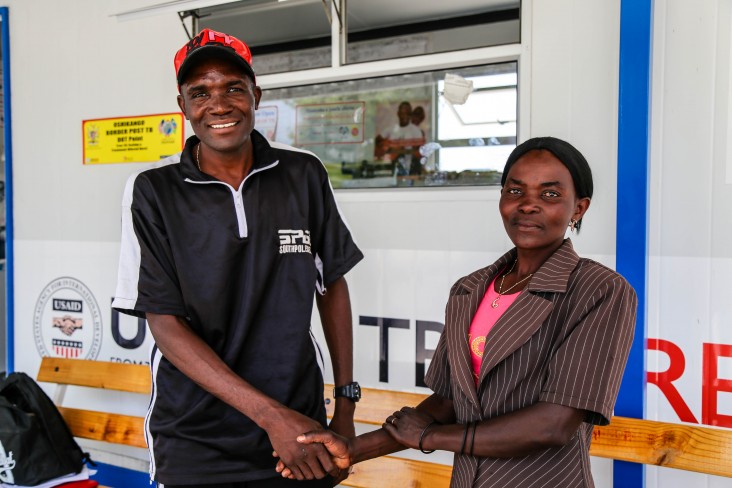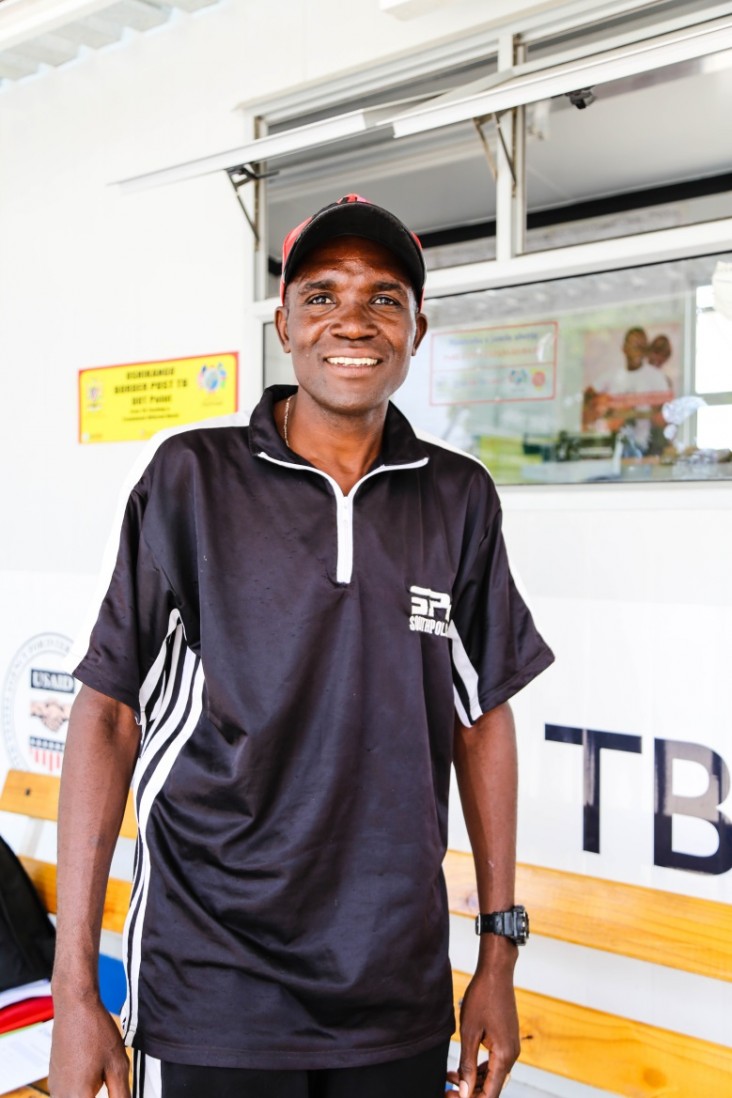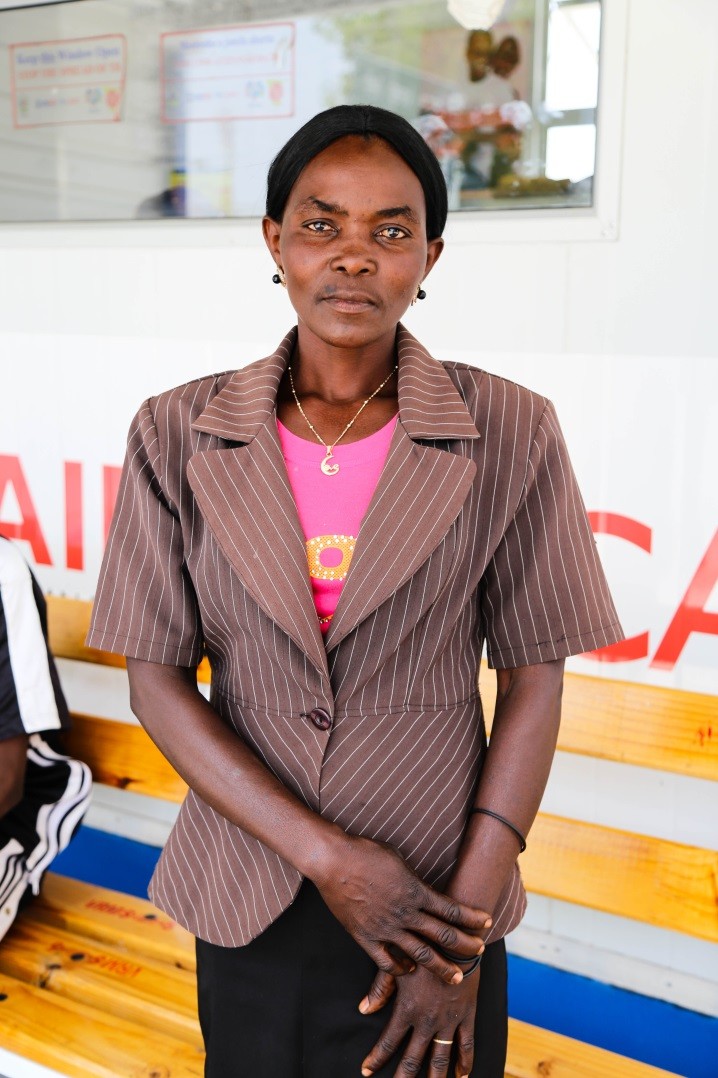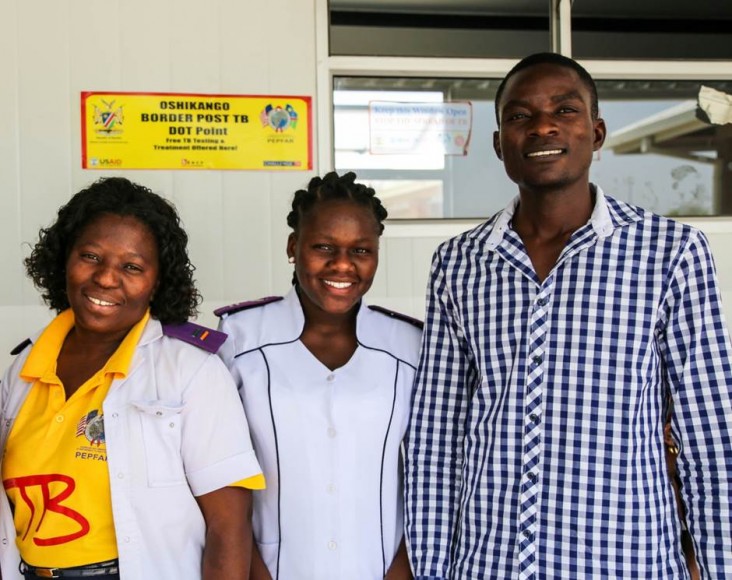
Standing on the border of Namibia and Angola, on one side, signs in English welcome you to Namibia. On the other, signs in Portuguese issue warm greetings to Angola. People, animals, motorcycles and vehicles freely pass back and forth across the two countries.
For some, crossing the border is a routine occurrence in order to access much needed healthcare services. One organization, the Koninklijke Nederlandse Centrale Vereniging (KNCV) Tuberculosis Foundation provides access to integrated tuberculosis (TB) and HIV services across Namibia with their direct observed therapy (DOT) points. In Oshikango, a town located right on the Namibia-Angola border, many patients come from Angola to access healthcare services, including free TB and HIV treatment.
Supported by the U.S. Agency for International Development (USAID), through the President’s Emergency Plan for AIDS Relief (PEPFAR), KNCV has worked in Namibia since 2004. In addition to the DOT points, KNCV also supports the Ministry of Health and Social Services in implementing their strategic plans of the national TB program, including developing guidelines, creating training materials, training healthcare workers and providing direct patient care.
In 2005, KNCV started implementing their DOT points in underserved communities throughout Namibia in an effort to decrease waiting times and to shorten distances traveled to access healthcare services. Many Namibians live far from district hospitals and often face long queues and wait for hours to see healthcare providers, or even refill medications.
KNCV focuses on creating healthcare service points that integrate access to HIV and TB services. In Namibia, TB/HIV co-infection is common, and often the diagnosis of one leads to the diagnosis of the other. As a result, TB clinics are designed to be an entry point for HIV testing. If a patient comes in with symptoms of TB and tests positive, he or she is also recommended for HIV testing. Likewise, in many anti-retroviral therapy (ART) clinics across the country, if a patient who is HIV-positive has symptoms similar to TB, they are referred for TB testing. Thus, by providing both services closer to rural communities, KNCV strives to create a one-stop shop for both TB and HIV patients; which usually results in better outcomes for the two conditions.
“Four in every ten TB patients are likely to be HIV-positive,” says Dr. Abbas Zezai, who serves as the country director for KNCV in Namibia.
“Integrated TB/HIV service is much needed and optimizes the use of the DOT points distributed at strategic sites throughout the country. TB patients receive TB medicines daily at the DOT points and are also offered HIV counseling and testing. If HIV-positive, they are assisted to commence ART as soon as possible,” explains Zezai.
In 2014, KNCV expanded its support in northern Namibia, and a DOT point was established in Oshikango, near the border with Angola.

Jeremiah Ita is a new client at the Oshikango DOT point. He was first tested for HIV at Engela District Hospital. After testing positive, he was subsequently referred for TB testing, where he also tested positive for TB. Ita started ART medications in August of 2016, shortly after receiving the results of his HIV test. Both his TB and ART medications were initiated at Engela District Hospital, but he has since been referred to the KNCV Oshikango DOT point.
Ita travels from Onehoni, a town located in the Cunene province of Southern Angola to Oshikango to receive his TB and ART medications. He explains that in Angola, when a patient goes for treatment, they are expected to pay for the medications themselves, even though ART is supposed to be free. Oftentimes, many clinics and hospitals are out of stock.
“ARVs are supposed to be free,” Ita says, “but they are not always available.” Ita has now been consistently taking his TB and ART medications since August, and plans to finish his course of medication by early 2017.

Helena Leo is a regular client at the Oshikango DOT point. She has been on ART since 2007, but started taking TB medications in March 2016. Leo started taking her TB medications at the Engela District Hospital, but for easier access was referred to the Oshikango DOT point for both her TB and ART medications.
In addition to coming for her own medications, Leo comes to visit her husband who is currently battling multi-drug resistance TB (MDR-TB). Because MDR-TB treatment requires careful monitoring to avoid negative side effects from strong medications, her husband has been at Engela District Hospital for the past 8 months. Despite the long time, she is cheerful and says he will be discharged soon.
Johana Hedimbi, a TB field promoter who assists with initiating clients on treatment and provides adherence support, shares with us that Leo’s test results have recently come back from the lab.
“Her lab results came in today,” says Hedimbi, “they show that she is cured of tuberculosis.”
Additionally, because Leo is considered a stable patient who has been taking ART medications consistently and no longer has TB, she now qualifies to pick-up a three-month supply of ART at the DOT point, as opposed to coming every month.
“I will still come to see my husband,” says Leo with a smile. Once her husband is discharged, it will be much easier for her to come every three months for her ART medication.
To date, KNCV has built and supported 45 DOT points in eight regions of Namibia. These TB/HIV DOT points serve to help overburdened facilities both in urban and rural areas by reducing long queues, and avoiding cross-infection from patients to patients and healthcare workers. The introduction of the DOT model is particularly helpful to Namibians living in rural areas that face long distances to get to health centers and hospitals. By providing same day appointments where clients can access medications and testing for TB and HIV, KNCV is also reducing congestion at hospitals, since clients can access services closer to home.
Supported by USAID, KNCV is increasing the number of Namibians who are cured of TB and have access to ART to manage their disease. From 2005 to 2015, KNCV has been able to help successfully treat 80% of TB/HIV co-infected patients of tuberculosis. They plan to continue expanding their TB/HIV DOT points, with the hope that by 2019, 100% of Namibians co-infected with TB and HIV will have access to the services they need to live long and healthy lives.








Comment
Make a general inquiry or suggest an improvement.